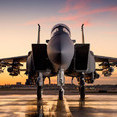
Turkey's Ready! - Initial impressions
By
Caesar, in Digital Combat Simulator Series General Discussion
-
Similar Content
-
By MigBuster
The Boeing CH-47F Chinook fondly referred to as ‘The Hook’ by US military personnel, stands today as the premier multi-mission rotary wing aircraft in use with the US Army, US Army Reserve, National Guard and 20 other nations including Canada, the United Kingdom, Netherlands, Japan, Italy, Greece, Spain, South Korea, Australia, Türkiye, India and the United Arab Emirates. Embodying a unique tandem rotor design this massive helicopter excels in all its roles, including cargo and troop transportation, sling load operations, search and rescue, casualty evacuation, special operations, and humanitarian assistance in disaster scenarios.
Engineered for exceptional stability and control, the CH-47F twin engine, tandem rotor configuration ensures maximum agility and facilitates straightforward loading and unloading procedures. This design uniquely positions the CH-47F for operation in environments inaccessible to others. The absence of tail rotor interference permits rear ramp access on varied terrains, including unprepared or mountainous locations, capitalising on its remarkable landing capability. Furthermore, the aircraft's design facilitates high-altitude flight up to 20,000 feet, surpassing other helicopters in its weight category.
The CH-47F is equipped with a state-of-the-art, fully integrated digital cockpit management system; the Common Avionics Architecture System (CAAS) Cockpit, in synergy with a Digital Automatic Flight Control System (DAFCS). These advanced systems enhance cargo-handling efficiency while significantly boosting mission performance and all weather situational awareness. CH-47F also offers side and rear door gunner positions, a radar warning receiver with chaff and flare dispensers for auto protection.
With the capability to cover extensive distances swiftly, the CH-47F can be outfitted with extended range fuel tanks and is compatible with air-to-air refuelling, thus extending its operational range further than ever before. This capability underscores the aircraft’s adaptability and endurance, making it a formidable asset in any fleet.
In total some 1'200 plus CH-47 helicopters of all variants were delivered. This icon of a war machine saw combat service in all the major theatres since its inception, notably Vietnam, Iran, Libya, The Falklands, The Balkans, Iraq and Afghanistan.
Capabilities of the CH-47F
Tandem Rotor Design: The CH-47F features a distinctive tandem rotor system with two counter-rotating rotors. This design provides exceptional handling qualities and allows for a large lift capacity, which is crucial for carrying heavy payloads. The absence of a tail rotor also enhances safety in confined areas and simplifies maintenance, offering unhindered rear cargo and troop loading in addition to side door access. Powerful Performance: Powered by two Honeywell T55-GA-714A engines, the CH-47F offers impressive power and performance. These engines deliver up to 4,868-shaft-horsepower combined, enabling the aircraft to reach speeds over 175 mph (282 km/h) with a payload of more than 21,000 pounds (9,500kg). Cargo Handling and Versatility: The CH-47F's large cargo hold can accommodate a wide variety of loads, from standard palletized goods to vehicles and artillery, as well as the fuel cells for “Fat Cow” operations. Its rear-loading ramp and three external cargo hooks provide multiple options for loading and unloading, facilitating efficient logistics operations under diverse conditions. Advanced Avionics and Systems: The “glass-cockpit” of the CH-47F is equipped with advanced avionics, including a Rockwell Collins Common Avionics Architecture System (CAAS) cockpit, BAE Systems' Digital Advanced Flight Control System (DAFCS), night vision-compatible displays, and modern navigation systems. These enhancements improve situational awareness and flight safety, particularly in challenging environments. Crew Capacity and Configuration: Typically operated by a crew of three (two pilots and a flight engineer), the CH-47F can also carry up to 3 gunners. Enhanced Survivability: Advanced countermeasures suite, which includes radar warning receivers and infrared countermeasures. Its rugged airframe and systems redundancy are designed to withstand significant damage. The CH-47F is an essential component of any military or humanitarian fleet, capable of performing in the most demanding situations. Its enduring design and continual updates ensure that it will remain a key player in aviation for years to come.
Key Features of the DCS: CH-47F for early access release:
Highly detailed external and internal modelling, including cockpit and cargo hold Unmatched helicopter flight dynamics that only DCS can provide Fully interactive, VR-ready cockpit Full set of features will be announced prior to early access Pre-purchase yours today!
Don’t miss the exclusive 30% discount during the pre-purchase phase. Hurry! This offer only lasts until launch.
(Text from Eagle Dynamics)
-
By JamesWilson
Hi everyone,
I'm trying to recreate the 1st Gulf of Sidra Incident with my F-14A Tomcats and my Su-22M3 Fitters, doing it extremely historically accurate, paying attention to every little detail.
So far i've done everything, and it's almost identical to the real one, but there's ONE issue i can't figure out, let me explain:
During the morning of the 19th of August 1981 two F-14A Tomcats intercepted two Libyan Su-22M3 Fitters in the Gulf of Sidra.
The Fitters were equipped with two AA-2 "Atoll".
Just before the merge, while nose-to-nose, one of the two Fitters fired a missile to one of the two Tomcats, but being the missile a very old and primitive heatseeker, it started tracked and going for the Tomcat, but as soon as the F-14 made a slight break, the Atoll lost its track.
The PROBLEM IS:
There's no way i can make the Fitters shoot the missiles before merging, if only the AA-2, or any other equippable missile was all-aspect or radar guided just like the R-23, i think it would work.
I tried having a head-on merge with two Mig-23 Floggers equipped with radar guided R-23s and they shot at me before merging.
I tried all other available missiles and nothing changed, some didn't show either.
I tried copying and pasting the Data file from the Aim-7 to the R-60 Data file, and nothing changed.
I tried changing the loadout file to R-23, but the Fitters show up without any weapon since there's no R-23 option in loadout for Su-23M3s, so i think it's not possible to have them (and would be historically inaccurate too).
I tried changing enemy difficulty from Normal to Hard, but nothing changes still.
The only thing the Fitters do is shooting their guns just before the merge, but no missiles are fired when nose-to-nose.
Is there a way to fix this? A way i can make my Fitters fire at least one of their missiles when we're nose-to-nose, just like when i got nose-to-nose against Floggers equipped with R-23s?
Is it a problem with the enemy AI? Or with the missiles? Or maybe even with the Su-22M3 Fitter i'm using?
Thank you very much for helping me
-
By JamesWilson
Hi,
after seeing the TMF F-14 has wrong and inaccurate speed and fuel indicators, i found out the default Third Wire F-14 has working and accurate ones, but i dont wanna use it cause the TMF Tomcat is better and the cockpit too more realistic too, so can you switch the speed and fuel indicators on the TMF F-14 with the default Third Wire F-14? And for fuel too? Do you need to 3D model and/or do something else other than edit some text files?
And is it or it's not possible to do?
Down here are 2 pictures from the correct cockpit in the default Third Wire F-14:
And 2 from the TMF F-14 (the inaccurate one):
Thanks for helping.
-
By JamesWilson
Hi everyone,
I just noticed that the speed indicator in the F-14 Tomcat by TMF (TheMirageFactory) only shows up to 800 kts, and the Mach indicator does not move, not letting you know the speed of the aircraft if you have your HUD turned off.
As you can see down here, i'm at Mach 2.23, but the indicator only shows 800 kts and doesn't go above. Obviously it adapts to my altitude, so if i'm higher, then the IAS is lower, but still should move, making it impossible flying at high speed without HUD turned on as i have it down here:
Another issue, maybe even worse than the previous one, is that the fuel indicator shows wrong numbers, or as i may think, it shows "a number less". For example: if i have 20000 pounds of fuel left, it should show 20000, but it shows 02000. This is a theory on how it works, not confirmed, and i'm gonna explain you why i think it is like that:
I hardly think i truly have 2000 pounds of fuel left, cause i choose Fuel 100% and tried climbing and flying for a long time with full afterburner, and the numbers slowly started going down, even reached the point of burning the engine at Mach 2.30and the fuel wasn't gone yet, it showed i had like 00700 left, so i presume it's 20000 in reality, otherwise i would have been out of fuel in no time, since it's a quantity even under the bingo quantity, but i flew for minutes and minutes in full afterburner, and at 8x speed, so. Speaking of Bingo, there's no bingo indicator.
Here's a picture of the fuel indicator:
I tried the default F-14 cockpit, and even if that one shows correctly both speed and fuel indicators and even if it's a great cockpit, i personally like more and find more realistic and immersive the TMF one.
In the end, since these two indicators are crucial, especially for flying without HUD, and the fuel indicator especially, since there's no way to know how much fuel you have left even with HUD turned on other than the cockpit indicator.
So, what i'm asking is:
Is there a way to fix these? A mod that remakes the indicators? Or another cockpit that is not the default one that i can use to swap this one?
Thanks in advance for helping me.
-
By Tonci87
I´m sure you have seen it in some movie, or read it in a story.
Someone who has no clue about airplanes has to get in one and fly off to somewhere.
They usually just get in and fly away, but it is really that simple?
Since I´m new to the flightsim genre I decide to dedicate my first flight to answering that question.
https://www.youtube.com/watch?v=VMxr0QLArPc
-



